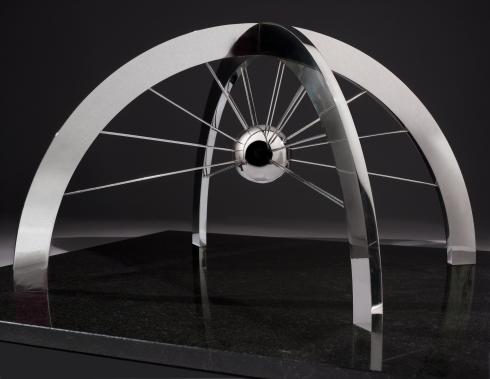
Media Inquiries
Public Inquiries
The Smithsonian’s National Air and Space Museum awards its Michael Collins Trophy annually for Lifetime and Current Achievements. The 2021 recipients are Gene Kranz for Lifetime Achievement and the SpaceX Crew Dragon Team for Current Achievement; they will receive their awards at a ceremony at the museum’s Steven F. Udvar-Hazy Center in Chantilly, Virginia.
Established in 1985, the award recognizes outstanding achievements in the fields of aerospace science and technology and their history. Trophy winners receive a miniature version of “The Web of Space,” a sculpture by artist John Safer. The renaming of the trophy in 2020 (previously the National Air and Space Museum Trophy) recognizes Collins’ contributions to aerospace and his service to the museum as director during a critical time in its evolution.
“We are honored to award two worthy and inspiring recipients the 2021 Michael Collins Trophy,” said Chris Browne, acting director of the museum. “Both Gene Kranz and the SpaceX Crew Dragon Team have advanced human space exploration in major ways, not only for our country, but for the world.”
2021 Michael Collins Trophy Recipients
Kranz will receive the 2021 Michael Collins Trophy for Lifetime Achievement honoring his remarkable accomplishments and success with NASA’s Mission Control for 34 years, from Project Mercury through STS-61, the first Hubble servicing mission. He began his career in the U.S. Air Force, flying high-performance jet fighters including the F-80, F-86, and F-100. In 1958, he worked as a flight-test engineer for McDonnell Aircraft developing the Quail Decoy Missile for B-52 and B-47 aircraft. Kranz became assistant flight director for Project Mercury with the NASA Space Task Group at Langley, Virginia, in 1960. He assumed flight director roles with Project Gemini and eventually the Apollo Program, including Apollo 11. His leadership during the Apollo 13 crisis became well known to subsequent generations thanks to the popular Ron Howard film Apollo 13 (1995) as well as Kranz’s own book and public speaking. He continued providing expertise for many other NASA missions throughout his career, including the Skylab Program and Space Shuttle operations. Kranz receives this prestigious award as a result of a career of excellence and service in NASA’s space program.
SpaceX is being awarded the 2021 Michael Collins Trophy for Current Achievement after the company successfully launched and returned two NASA astronauts on a mission to the International Space Station in 2020 using its Falcon 9 rocket and Crew Dragon spacecraft. This marked the first time NASA astronauts traveled on a U.S.-made and -operated spacecraft since 2011, when the agency retired the space shuttle orbiters, and the first time NASA astronauts traveled on vehicles owned and operated by a private company. The SpaceX Crew Demo-2 mission helped restore American independence in human spaceflight. Since SpaceX was founded in 2002 with the objectives of reducing the cost of space transportation and enabling a multi-planetary future for humans, it has seen its share of setbacks but never shied away from the daunting challenges. It has treated failures as opportunities to improve and innovate and become the first private company to provide commercial human spaceflight into Earth orbit.
More information about the Michael Collins Trophy and a complete list of past winners are available at https://airandspace.si.edu/michael-collins-trophy
The Michael Collins Trophy event is made possible through the support of Atlas Air Worldwide, BAE Systems, Blue Origin, Booz Allen Hamilton, The Claude Moore Charitable Foundation, Jacobs, Leidos, National Air Traffic Controllers Association, National Business Aviation Association, Pratt & Whitney, Seabury Securities, Sierra Nevada Corp. and Thales.
The National Air and Space Museum in Washington, D.C., is located at Sixth Street and Independence Avenue S.W. The Steven F. Udvar-Hazy Center is located in Chantilly, Virginia, near Washington Dulles International Airport.
# # #